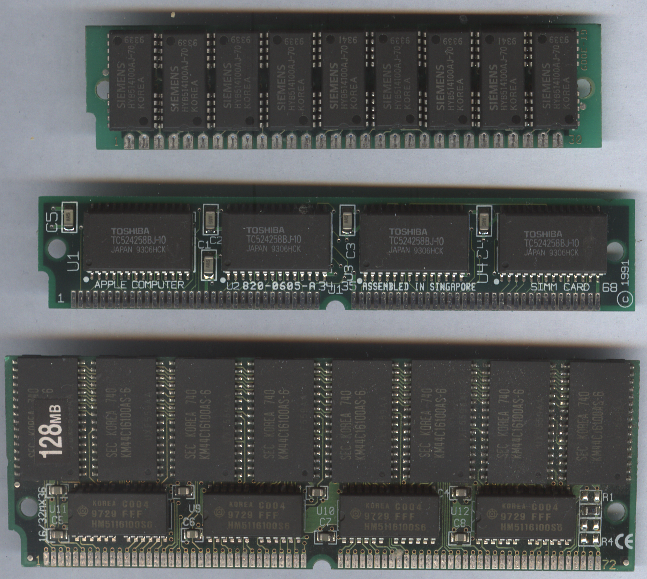|
EOS Memory
EOS memory (for ECC on SIMMs) is an error-correcting memory system ''built into'' SIMMs, used to upgrade server-class computers without built-in ECC memory support. The EOS SIMM itself does the error checking, with reduced need for ECC memory Error correction code memory (ECC memory) is a type of computer data storage that uses an error correction code (ECC) to detect and correct n-bit data corruption which occurs in memory. ECC memory is used in most computers where data corruption c ... modules and support. The technology was introduced by IBM in the mid-1990s. References External linksEOS definition at PCmag Computer memory {{compu-hardware-stub ... [...More Info...] [...Related Items...] OR: [Wikipedia] [Google] [Baidu] |
SIMM
A SIMM (single in-line memory module) is a type of memory module containing random-access memory used in computers from the early 1980s to the early 2000s. It differs from a dual in-line memory module (DIMM), the most predominant form of memory module since the late 1990s, in that the contacts on a SIMM are redundant on both sides of the module. SIMMs were standardised under the JEDEC JESD-21C standard. Most early PC motherboards (8088-based PCs, XTs, and early ATs) used socketed DIP chips for DRAM. As computer memory capacities grew, memory modules were used to save motherboard space and ease memory expansion. Instead of plugging in eight or nine single DIP chips, only one additional memory module was needed to increase the memory of the computer. History SIMMs were invented in 1982 by James J. Parker at Zenith Microcircuits and the first Zenith Microcircuits customer was Wang Laboratories. Wang Laboratories tried to patent it and were granted a patent in April 1987. ... [...More Info...] [...Related Items...] OR: [Wikipedia] [Google] [Baidu] |
Server (computing)
In computing, a server is a piece of computer hardware or software (computer program) that provides functionality for other programs or devices, called " clients". This architecture is called the client–server model. Servers can provide various functionalities, often called "services", such as sharing data or resources among multiple clients, or performing computation for a client. A single server can serve multiple clients, and a single client can use multiple servers. A client process may run on the same device or may connect over a network to a server on a different device. Typical servers are database servers, file servers, mail servers, print servers, web servers, game servers, and application servers. Client–server systems are usually most frequently implemented by (and often identified with) the request–response model: a client sends a request to the server, which performs some action and sends a response back to the client, typically with a result or ackn ... [...More Info...] [...Related Items...] OR: [Wikipedia] [Google] [Baidu] |
ECC Memory
Error correction code memory (ECC memory) is a type of computer data storage that uses an error correction code (ECC) to detect and correct n-bit data corruption which occurs in memory. ECC memory is used in most computers where data corruption cannot be tolerated, like industrial control applications, critical databases, and infrastructural memory caches. Typically, ECC memory maintains a memory system immune to single-bit errors: the data that is read from each word is always the same as the data that had been written to it, even if one of the bits actually stored has been flipped to the wrong state. Most non-ECC memory cannot detect errors, although some non-ECC memory with parity support allows detection but not correction. Description Error correction codes protect against undetected data corruption and are used in computers where such corruption is unacceptable, examples being scientific and financial computing applications, or in database and file servers. ECC can als ... [...More Info...] [...Related Items...] OR: [Wikipedia] [Google] [Baidu] |
